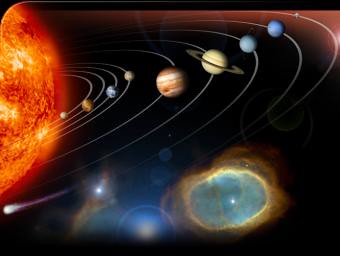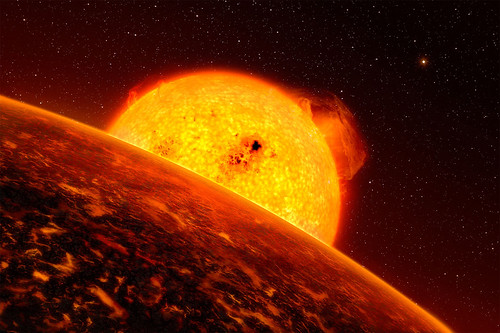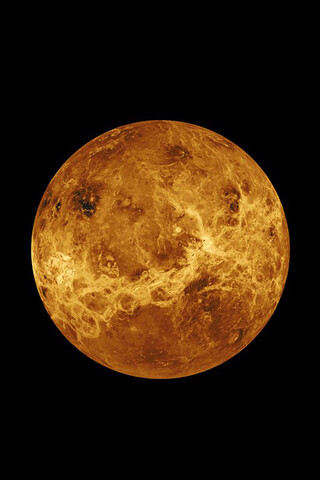| |
|
 |
| solar_system3 |
by Royalty-free image collection on Flickr |
|
- The eight planets in our solar system are Mercury, Venus, Earth, Mars, Jupiter, Saturn, Uranus, and Neptune.
- There are currently Five dwarf planets that have been discovered; Eris, Pluto, Ceres, Haumea and Makemake.
- Our asteroid belt is called the Kuiper Belt. It is located just beyond the planet Neptune, and continues past Pluto.
- And of course, in the center of it all, is the Sun.
|
 |
| Most Earthlike Exoplanet Started out as Gas Giant |
by NASA Goddard Photo and Video on Flickr |
|
The Sun
- The Sun is the center of our solar system.
- It is a giant ball of flaming gases, mainly Hydrogen and Helium.
- Its light and intense heat is what warms our planet and keeps us alive.
- All the other planets, dwarf planets, and asteroid belt that all revolve around the Sun are drawn by its enormous gravitational pull.
- Our Suns classification is a 'Yellow Dwarf' or 'G2V' star.
|
 |
| Mercury |
by chrismeller on Flickr |
|
Planet Mercury
- Mercury is the planet closest to the sun.
- It is now the smallest planet we know of (not including dwarf planets).
- Its surface temperature rises and falls drastically, as much as 1000 degrees from day to night.
- It is a small, rocky planet, pitted with craters.
- It is the second hottest planet in our solar system.
- Mercury has no moons or rings.
- Its year is 88 Earth days long and its day is 58 Earth days and 15 hours.
|
 |
| Venus |
by chrismeller on Flickr |
|
Venus
- The planet Venus is the second closest planet to the sun.
- Venus has no moons or rings.
- It has large volcanoes, created over rips in Venus' surface, that are still active.
- Venus' day is equal to 243 Earth days.
- Its year is 225 Earth days.
- Venus' day is longer than its year.
- It is the hottest planet in our solar system.
|
 |
| Earth, courtesy Apollo 17, and probably the most reproduced image of all time |
by woodleywonderworks on Flickr |
|
Earth
- Earth is our home planet.
- It is the only known planet to have liquid water on the surface, and is rich with life.
- Earth has one moon, and no rings. Our year is 365 days long and our day is 24 hours.
- We are the third closest planet to the sun.
- Our atmosphere is made up of 77% nitrogen and 21% oxygen and traces of other gases.
|
|
Mars
- Mars is the fourth closest planet from the sun.
- Often called 'The Red Planet', Mars has a layer of iron oxide, or rust, which gives it a red tint.
- Its year is equal to 687 Earth days, and a day is 24 hours and 39 minutes.
- Mars has two moons; Phobos and Deimos.
- There is ice underneath the surface of Mars, and there may have been rivers running on Mars a very long time ago.
|
 |
| Jupiter |
by chrismeller on Flickr |
|
Jupiter
- Jupiter is the largest planet n the solar system.
- It has over 60 moons.
- One of its moons (Ganymede) is even larger than Mercury.
- Jupiter is one of the gas planets.
- Its day is about ten hours, and its year is about 4330 days.
- Jupiter also has rings.
- Jupiter is known for its giant red spot (Large enough to fit in 3 Earths) on its surface.
- It is probably a giant storm, but no one knows for sure.
|
 |
| Saturn |
by chrismeller on Flickr |
|
Saturn
- Saturn is a gas planet.
- It is mostly known for its incredible rings, which are mostly made from ice and contains some rocky particles covered in ice.
- It has about 50 moons discovered.
- Saturn is the second largest planet.
- Its year lasts about 10 750 Earth days.
- Saturn is the least dense of the planets.
- A day on Saturn is about 11 hours long.
|
Uranus
- Uranus has more than 20 moons.
- Its axis is very strangely tilted, it looks practically horizontal!
- Uranus is the third gas planet in the solar system.
- Its year is about 30 660 Earth days long, and its day is about 17 hours.
- Uranus also has rings.
- Uranus is the seventh planet from the sun.
|
 |
| Voyager's Neptune |
by thebadastronomer on Flickr |
|
Neptune
- Neptune is the eighth planet from the sun.
- If we included Pluto as a true planet, Neptune would usually be the second farthest from the sun, but every now and then, Pluto would cross over Neptune's orbit, and Neptune would become the farthest planet from the sun.
- It has over 10 moons.
- Neptune is the fourth gas planet.
- Its day is about 16 hours.
- A year would be about 60 190 Earth days.
- It is the coldest true planet.
- It has a great dark spot, much like Jupiter's red spot.
|
 NeoK12.com - Educational Videos, Lessons, Quizzes & Presentations
NeoK12.com - Educational Videos, Lessons, Quizzes & Presentations







